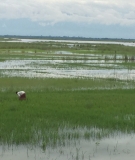What is life like for the 25,000 people who live on large riverine islands in India's Teesta River? Bharat Seth visited the riverine communities recently, and brings back impressions of what it means to live with floods.

Date: Monday, August 8, 2016 - 04:45
Last month, a line of houses and shops along the Teesta River were demolished by the district administration in the Indian state of West Bengal. The structures set riverside of the 29th Mile village were at risk of being inundated by the fast rising backwaters of a 32.5-meter high barrage.
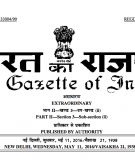
Date: Wednesday, July 13, 2016 - 03:22
India has a new environment minister in Anil Madhav Dave.

Date: Friday, July 8, 2016 - 04:16
Last week, India’s Minster of Power went on record saying that India can meet its electricity demand for the next ten years without installing any additional hydropower capacity. This proclamation is a fillip to activists campaigning against the destructive cascade of hydropower dams planned in the upper reaches of Himalayan rivers.
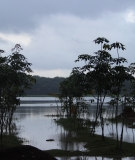
Date: Monday, June 13, 2016 - 03:05
With an enduring drought ravaging many parts of the country, last month the Prime Minister waxed eloquent on the need to safeguard water during his monthly radio monologue.

Date: Wednesday, May 18, 2016 - 23:57
The people's struggle in the Teesta River basin in Sikkim (India) has gone through a change of guard recently. Tseten Lepcha stepped down as working president earlier this year. He had a telephone conversation with Bharat Lal Seth on the changes in their approach to campaigning for a pro-people environment in the Himalayan state.

Date: Sunday, May 15, 2016 - 23:31
After a seven-year struggle, one Indian village has won the right to decide the fate of a proposed hydropower project in its area. Critics fear this will hamper development in India...but are they right?

Date: Tuesday, April 12, 2016 - 02:30
It has been more than ten years since the 260-meter-high Tehri Dam was commissioned on the Bhagirathi River, a headwater stream of the Ganga. Vimal Bhai, an activist working in the upper reaches of the Ganga for more than two decades, spent years fighting the project and, after it was completed, catalogued the failures of the state government and dam company.

Date: Thursday, January 14, 2016 - 06:24
Vimal Bhai is the Convener of Matu Jan Sangathan, a collective that has been advocating for rights of communities impacted by large hydropower projects and dams in India’s Himalayan state of Uttarakhand.

Date: Wednesday, January 13, 2016 - 05:46
Himanshu Thakkar is the coordinator of the South Asia Network on Dams, Rivers and People (SANDRP). He is blogs frequently at https://sandrp.wordpress.com and can be contacted at ht.sandrp@gmail.com
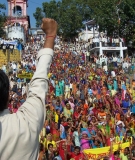
Date: Friday, January 8, 2016 - 02:24
Proponents claimed that privatizing India's Maheshwar Dam would speed up construction and bring in needed funds. Now it looks like public money will once again be used to pull a private company out of trouble.
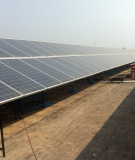
Date: Thursday, October 15, 2015 - 03:56
Urban planners are turning to rooftop solar in India to meet the country's ambitious renewables targets. Bharat Lal Seth looks at what this decentralized option means for a country that's relied on big hydro for many decades.

Date: Wednesday, October 14, 2015 - 04:33
An interview with Soumya Dutta of the Beyond Copenhagen collective. We talk with him about India's electricity growth trajectory and the future of renewables.
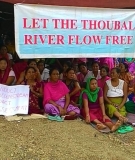
Date: Sunday, August 23, 2015 - 23:16
People living in villages downstream from the Mapithel Dam in Northeast India have suffered many sleepless nights this past month. The unfinished dam has been reportedly leaking since Manipur’s Irrigation and Flood Control Department hastily began impeding the Thoubal River and filling the reservoir in January.
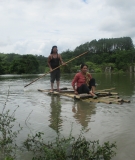
Date: Friday, August 7, 2015 - 04:26
The Mapithel valley in northeast India is changing drastically right now, as waters rise behind the Mapithel Dam. Jitin Yumnam explores what it's like to be flooded out of your home.

Date: Tuesday, July 28, 2015 - 05:10
Himachal Pradesh, a North Indian Himalayan state, is on an uninterrupted quest to develop run-of-river hydropower projects. The projects are planned for five major river basins, with a cumulative target of close to 27,000 megawatt (MW). Perhaps the most heavily affected of these rivers is the Chenab, which comes into being at the confluence of the Chandra and Bhaga rivers in the Lahaul Valley.

Date: Wednesday, July 1, 2015 - 05:14
In January this year, the Thoubal River was impeded by the Mapithel Dam. In the pipeline since the 1980s, the commissioning of the dam meant that the backwater reservoir slowly began to rise, fill and spread, even though resettlement had not been completed. A despicable act by the Manipur government to forcefully commission the Thoubal Multipurpose Project. By June, due to the rains in the northeastern Indian state, the dam reservoir began to rise rapidly and submerged an extensive area of Chadong village, where many project-affected people reside. The reservoir began to submerge their agricultural land, grazing grounds and forest.

Date: Tuesday, June 30, 2015 - 00:29
This is a guest blog by Ratan Bhandari, a Kathmandu-based water resource activist.Last month, the residents of Basari village in Nepal informed officials about a nearby landslide that damaged five houses. Rising to the call of duty, at half past seven in the morning the District Administration and Police Officers arrived and took stock of the situation.

Date: Thursday, June 25, 2015 - 04:19
The Sardar Sarovar Dam on the River Narmada – perhaps the most controversial dam project in the world – continues to create conflicts between the Indian government, the courts, and the hundreds of thousands of people affected by the dam. Last month, a six-member team comprising officials from two national political parties and independent experts conducted a fact-finding tour to understand the ground realities concerning the project.
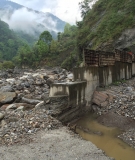
Date: Friday, June 5, 2015 - 07:43
Assessment studies for dam and hydropower projects in India attempt to look closely at the impacts of river-inhibiting civil works, but the full impact of tunneling is often evaded, or at best understated. This is just one reason why run-of-river hydropower projects (HEP) are wrongly labeled relatively benign as compared to reservoir dam-toe HEPs.
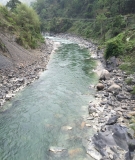
Date: Friday, May 29, 2015 - 00:19
Last month, the two-member South Asia team travelled to the West Sikkim Hills, a northern Indian region nestled in the Himalayan mountains, to visit hydroelectric project (HEP) sites and speak with project-affected people. During our travels, the Gorkha earthquake on April 25, with its epicenter in Nepal, was felt across north India. Hundreds of buildings crumbled, killing thousands in Nepal.

Date: Wednesday, May 13, 2015 - 05:08
After the devastating Gorkha earthquake of April 25, which killed thousands and left many more homeless, details are slowly emerging that power plants and dam projects were extensively damaged across the country.

Date: Wednesday, April 15, 2015 - 23:21
Last year the Jhelum River Basin received unprecedented rainfall in the Kashmir Valley. It was the wettest September in recorded history; several weather stations broke their 24 and 48 hour records.

Date: Thursday, April 9, 2015 - 05:25
In India, the hydropower generated per MW installed continues its downward slide, a trend for the past two decades. There are many reasons why it's dipping: unviable projects, unviable installed capacities, over-optimistic hydrological assumptions, over development (development beyond the carrying capacity of the basin), catchment degradation, high rates of sedimentation, inadequate repair & maintenance, run of river projects (this phrase is a misnomer, these projects do not generate power from the run of the river but through a dam and a tunnel), changing monsoon patterns due to climate change, etc.
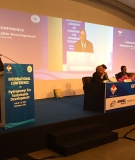
Date: Monday, March 23, 2015 - 05:30
Disclaimer: This is a minority report from the “International Conference on Hydropower for Sustainable Development”, which I attended the first week of February at Dehradun, India. The title was a bit of an oxymoron; a more suitable one would have been: “International Conference for Sustainable Development of the Hydropower Sector”.
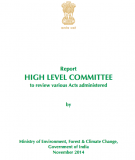
Date: Wednesday, March 4, 2015 - 02:09
There are two divergent views concerning the role of the environment ministry in India. One group seems to think it provides, albeit inadequately, the much needed checks and balances to oversee India’s environment and forest policy. Others view it as a roadblock ministry that holds up infrastructure projects.

Date: Wednesday, February 18, 2015 - 00:16
Some three or four years back I travelled to the Alaknanda River Basin in Uttarakhand. At the time I was working as a journalist and writing a story on the Pinder River, the last free-flowing tributary of the mighty Alaknanda.

Date: Thursday, January 15, 2015 - 03:54
India Rivers Week was held November 24-27, 2014 at the WWF-India campus in New Delhi. A first of its kind gathering of more than 100 river activists working to protect, conserve and rehabilitate India’s rivers, the four-day meet sought to tackle a wide array of issues regarding river health.


